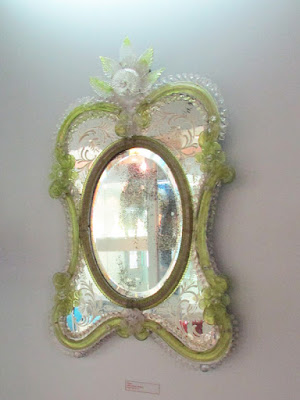The collections bring testimony of cultural, economic, and political life in Varaždin and its surroundings.
Ten rooms in the castle decorated in different styles
of previous periods revives the spirit and the lifestyle of previous centuries.
(Renaissance, Baroque, Rococo, Empire, Biedermeier, Historicism,
Art deco)
***
For me, the most interesting part of permanent
exhibition is a new unit Culture of clothing (opened in April 2014). This unit tends to present the culture of clothing
among the citizens and nobility in Varaždin in the period from 18th till the
mid 20th century.
BAROQUE AND CLASSICISM
The Corset-was an important part of clothing in the period of Baroque and Rococo.The essential accessory of the nobility and upper class was fan.
EMPIRE
Brisé fan (silk, ivory, early 19th century)
BIEDERMEIER
Special attention was given to hairstyles and the hats were in various shapes, trying to adapt to the complicated hairstyles.
Parasols were essential accessories.
Purses and wallets were commonly made of silk and luxuriously embroidered. Most popular was floral motif with birds, namely roses as the symbol the Biedermeier style.
Illyrian bag-1840.(velvet, gold thread, beads and sequin embroidery).
HISTORICISM
The last twenty years of the 19th century were characterized by round emphasized back female silhouette called Cul de Paris and Tournure.
Dress- Croatia, 1850 (silk taffeta, satin and rips,cotton twill)
Fan- China,19th century (varnished wood, mother of pearls, gouache on paper).
Ladies fashion magazine- La Mode Illustrée, Paris,1885.
SECESSION
Fashion at the turn of the 19th century followed the style of Historicism. The simplicity and practicality of Secession did not find its place in female fashion. The dresses,especially evening gowns, maintained lavish decoration with plenty of ruffles, lace and embroidery. Floral and herbal ornaments were dominant fashion motifs of Secession style, especially on lace.The luxurious fan and lace detail were made in special technique of lace making with tappers called Lepoglava or Brussels lace.
Fan-Vienna, end of 19th beginning of 20th century.
***
In the museum collection there is an interesting group of of objects related to beginnings of swimming and water activities at public beaches between two
world wars.
Women and children bathing suits, swimming requisite and sunglasses- early 20th century.
Thanks to the discovery of photography in 19th century, many fashion and life trends were documented and preserved.
The photos are really valuable documents of time and I'm so obsessed with documenting every single thing I have seen and every moment I have experienced. So, pardon me. :)
Thanks to the discovery of photography in 19th century, many fashion and life trends were documented and preserved.
The photos are really valuable documents of time and I'm so obsessed with documenting every single thing I have seen and every moment I have experienced. So, pardon me. :)






























































